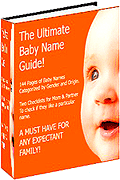Most Popular Baby Names - Names and their Meanings
Page 2
* With women aged 30-35 the chance drops to 1 in 7, and the success rate falls as they get older.
On average it will take a couple in their early to mid-twenties five cycles to conceive, and a couple in their early thirties ten cycles. One in ten couples have to wait more than a year before they succeed.
What If It's Not Working?
If you have been trying for a baby without success:
* Keep a temperature chart. After ovulation the woman's body temperature rises by about 0.2?C and maintains this higher temperature until her next period. By measuring temperature as soon as you wake and entering the reading on a chart, you can see when you ovulate. Ideally you want to have sex just before then. You can't turn the clock back of course, but the chart will tell you whether you ovulate at the same time each month and, if so, you can plan for the following month. The temperature rise is small and you may feel more confident with an ovulation kit available from your chemist.
* try to lower your stress levels. Stress can affect either partner and may reduce your chances of conceiving. Try to have a few days away from work just before ovulation is due.
* if you have been unsuccessful for a year or more it is worth talking to your doctor.
About The Author
Tony Luck runs websites all about babies: conception, pregnancy, the birth, and babycare; and a shop selling unique christening gifts. Visit the sites at http://www.baby-talk.co.uk and http://www.gifts-4-baby.co.uk.
|
Increase Your Chances Of Having A Baby
Back to Page 1
